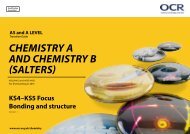CHEMISTRY B (SALTERS)
rbhW308ZeDB
rbhW308ZeDB
Create successful ePaper yourself
Turn your PDF publications into a flip-book with our unique Google optimized e-Paper software.
A LEVEL <strong>CHEMISTRY</strong> B (<strong>SALTERS</strong>)<br />
DEVELOPING CHEMICAL LITERACY SKILLS<br />
Coherence<br />
Learner responses to extended questions should be clearly<br />
thought out with connected ideas brought together. This<br />
means that learners need to think about all of the things<br />
they might want to include in their answer before starting to<br />
put pen to paper. It could even be worth jotting down brief<br />
notes on the points to make, and the order in which to make<br />
them, before writing the answer out in full. (In exams, rough<br />
working should be crossed out afterwards.) Responses that<br />
lack coherence are often caused by muddled thinking where<br />
learners use a ‘stream of consciousness / brain–dump’ approach<br />
of writing down bits of their answer in the order that they think<br />
of them.<br />
In a question, for example, that asks for a comparison of<br />
the structures and reactions of two organic compounds,<br />
learners might compare the structures and then move on to<br />
compare the reactions, describing a range of reactants in turn<br />
and comparing how the two compounds react with each.<br />
Alternatively, a learner might discuss the structure and reactions<br />
for one compound first, and then for the other – but in this<br />
case it would be important to make links back from the second<br />
compound to the first to make sure the comparison aspect is<br />
covered.<br />
Relevance<br />
Learner answers should be relevant to the specific question<br />
posed rather than a general response to the topic involved.<br />
Learners need to think about all the points that they might<br />
include in their answer before choosing those points that<br />
are relevant. It also means that they must carefully read the<br />
question so that they provide appropriate information.<br />
In response to a question, for example, that asks for a plan to<br />
distinguish between different alcohols using simple chemical<br />
tests, only those tests that will distinguish between alcohols<br />
should be included. Tests involving oxidation might reveal<br />
useful information but the preparation of esters would not<br />
since all the alcohols behave in a similar way. While including<br />
irrelevant information does not directly lead to loss of marks as<br />
negative marking is not used, it does use up exam time with no<br />
benefit, and increases the chance of writing down incorrect/<br />
contradictory ideas.<br />
Substantiated response<br />
A substantiated response is one in which statements are<br />
supported by evidence. Often a cause and its effect will be<br />
identified. The evidence and the consequence of the evidence<br />
should be clearly linked together.<br />
In a question, for example, that requires learners to use<br />
information from spectra to identify the structure of an organic<br />
compound they need to specifically link detail in the spectra<br />
with the information about the structure that the detail<br />
provides. The line produced by the molecular ion in the mass<br />
spectrum, for example, provides evidence for the molecular<br />
mass of the substance; absorptions in the IR spectrum provide<br />
evidence for the functional groups present in the molecule;<br />
splitting patterns in the proton NMR spectrum provide<br />
evidence about the number of hydrogen atoms on adjacent<br />
carbon atoms. Learners also need to appreciate that lack of<br />
absorptions at particular frequencies in the IR spectrum also<br />
provides useful evidence, this time about functional groups<br />
that are not in the molecule. Often, unique identification of the<br />
compound requires that several pieces of evidence must be<br />
used together, a bit like putting together the pieces of a jigsaw<br />
puzzle. Use of tables to compile information from interpretation<br />
of specta can be a useful way to ensure all relevant information<br />
has been extracted, and is presented in a logical fashion.<br />
Logical structure<br />
Learner responses should show a clear line of reasoning and<br />
a logical progression of ideas. Gathering thoughts together<br />
before starting to write is again critical to producing a clear<br />
narrative. Learners need to decide what they are going to<br />
write about and in what order they will present their ideas so<br />
that there is a logical flow from one point to the next. Often<br />
a question will be made up of several parts or ask for several<br />
pieces of information. It is important that learners check that<br />
they have answered all the parts of the question and have not<br />
spent a disproportionate time on just one part. Annotation of<br />
the question to identify all of these parts can provide a helpful<br />
check for learners when they are reviewing their outline plan<br />
and/or final answer.<br />
In answering a question, for example, that asks for a plan of an<br />
experiment to determine the enthalpy change of combustion<br />
of a fuel learners need to think about all of the stages<br />
involved. It may help them to try and visualise themselves at<br />
the laboratory bench so they can imagine what they would<br />
need to do and in what sequence they need to carry out the<br />
experimental procedures. They may also need to continue<br />
this line of reasoning to explain how data recorded during<br />
the experiment can be used to carry out the calculations<br />
required. Labelled diagrams can be helpful in descriptions of<br />
experimental planning as they can contain a large amount of<br />
information in a concise and coherent form.<br />
Connecting words<br />
Different types of questions require answers that include<br />
appropriate words connecting phrases together. If learners<br />
explicitly remember to use the right kind of word it will help<br />
them produce answers that are logical and coherent.<br />
In an answer, for example, to a question that requires a<br />
substantiated response, words and phrases such as ‘therefore,<br />
so, consequently, hence, for this reason, because’ may well<br />
prove useful.<br />
Where a learner sets out to contrast different structures or<br />
reactions, words and phrases such as ‘in contrast to, on the<br />
other hand, conversely, however, whereas’ would be helpful.<br />
If a particular sequence of events is required then words and<br />
phrases such as ‘firstly, secondly, then, next, after, finally’ might<br />
be chosen.<br />
Where experimental methods are being written, a numbered<br />
list of steps is an appropriate structure.<br />
4 © OCR 2017




